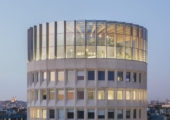May 11, 2013
JSA launches latest league table of European office furniture companies
 As the world gets smaller and the communications revolution continues apace, one relatively unnoticed casualty is the design individuality of offices. Time was when you could walk into an office and the furniture would tell you whether you were in Paris, Frankfurt, New York, Milan, Moscow or London. The colours, shapes, materials, construction and image of the furniture were all very local, almost parochial. Who could fail to be struck by the muddy oranges and greens of a French office? Or the inevitable mahogany or teak real wood veneers used in the UK? The panels, worksurfaces and storage units which made up US cubicles were rarely seen outside North America and the massive, dark wood desks and cabinets in Central European deliberately overawed visitors and staff alike.
As the world gets smaller and the communications revolution continues apace, one relatively unnoticed casualty is the design individuality of offices. Time was when you could walk into an office and the furniture would tell you whether you were in Paris, Frankfurt, New York, Milan, Moscow or London. The colours, shapes, materials, construction and image of the furniture were all very local, almost parochial. Who could fail to be struck by the muddy oranges and greens of a French office? Or the inevitable mahogany or teak real wood veneers used in the UK? The panels, worksurfaces and storage units which made up US cubicles were rarely seen outside North America and the massive, dark wood desks and cabinets in Central European deliberately overawed visitors and staff alike.

























May 10, 2013
The biggest challenge is building flexibility into an office design
by Mark Eltringham • Comment, Facilities management, Workplace design
(more…)